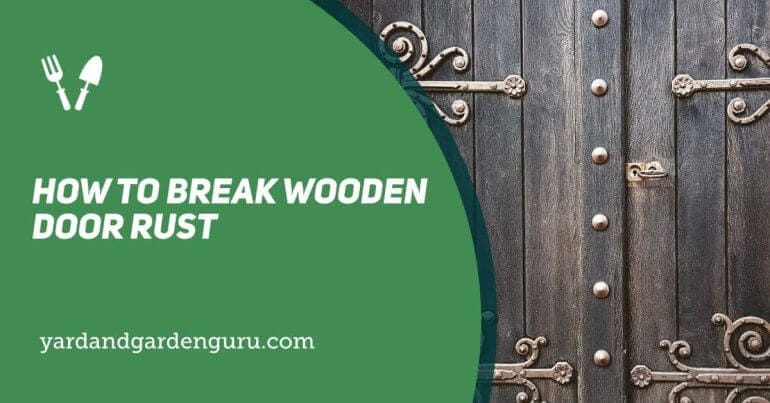Are you struggling with a stubborn rusted wooden door that’s affecting its functionality and aesthetics? Don’t worry, we’ve got you covered! In this comprehensive guide, we’ll walk you through effective steps on how to break the rust on your wooden door and restore it to its former glory. Say goodbye to squeaky hinges, flaky paint, and unsightly rust stains by following our expert tips and techniques. Let’s dive in and get your wooden door looking as good as new!

Preventing Rust on Wooden Doors: Tips and Tricks
Wooden doors are a beautiful and classic addition to any home. They add warmth and charm to the overall aesthetic. However, one common issue that homeowners face with wooden doors is the occurrence of rust. Rust can not only ruin the appearance of the door but also compromise its structural integrity over time. In this section, we will discuss some effective tips and tricks to prevent rust on wooden doors.

1. Choose the Right Material
The first step in preventing rust on wooden doors is to choose the right material. Opt for a high-quality wooden door that is resistant to moisture and humidity. Some types of wood, such as teak or cedar, are naturally more resistant to rot and decay, making them less likely to rust. Additionally, consider using a door that has been treated or coated with a protective sealant.
2. Regular Cleaning
Regular cleaning is essential in preventing rust on wooden doors. Dust and dirt can accumulate on the surface of the door, creating a breeding ground for moisture and rust. Use a mild detergent and a soft cloth or sponge to gently clean the door. Avoid using harsh chemicals or abrasive materials that can damage the wood or its finish.
3. Apply a Protective Finish
Applying a protective finish to your wooden door can help prevent rust. There are various types of finishes available, such as paint, varnish, or stain. Choose a finish that is specifically designed for exterior use and provides a barrier against moisture. Ensure that the finish is applied evenly and covers all surfaces, including the edges and corners of the door.
4. Maintain Proper Ventilation
Poor ventilation can lead to excess moisture, which can contribute to rust formation on wooden doors. Ensure that the area surrounding the door is well-ventilated to promote air circulation and prevent the buildup of condensation. If necessary, install vents or use a dehumidifier to maintain optimal humidity levels.
5. Repair and Seal Cracks or Damages
Inspect your wooden door regularly for any cracks or damages. Even a small crack can allow moisture to seep into the wood, leading to rust formation. Repair any cracks or damages promptly and seal them with an appropriate wood filler or sealant to prevent further moisture penetration.
6. Protect the Bottom of the Door
The bottom of a wooden door is particularly susceptible to water damage, as it often comes into contact with the ground and splashes from rain or irrigation. Consider installing a door sweep or threshold to protect the bottom of the door from direct contact with water. Regularly inspect the bottom of the door for any signs of damage and address them immediately.
7. Maintain a Good Drainage System
To prevent water from pooling around your wooden door, ensure that you have a good drainage system in place. Clear any debris or blockages from gutters and downspouts to allow proper water flow. Redirect water away from the door by using downspout extensions or installing a drainage grate.
8. Apply Rust-Inhibiting Products
In addition to the above preventive measures, you can also use rust-inhibiting products to protect your wooden door. There are specialized rust-inhibiting sprays and coatings available that create a protective barrier and prevent rust formation. Consult with a professional or your local hardware store for recommendations on the best products to use.
9. Regular Maintenance
Regular maintenance is key to preventing rust on wooden doors. Inspect your doors periodically for any signs of rust or damage. If you notice any issues, address them promptly to avoid further deterioration. Additionally, it is important to reapply the protective finish every few years to ensure continued protection against rust.
In summary, by selecting the right material, practicing regular cleaning and maintenance, applying a protective finish, and implementing preventive measures, you can effectively prevent rust on wooden doors. Protecting your doors from rust will not only enhance their longevity but also keep them looking beautiful for years to come.

Natural Remedies for Removing Rust from Wooden Doors
If you have wooden doors in your home, chances are you’ve encountered the annoying problem of rust. Rust can form on metal hardware attached to wooden doors, such as hinges, handles, or screws, and it not only looks unsightly but can also damage the wood if left untreated. While there are chemical rust removers available on the market, they can be harsh and may cause damage to the surrounding wood. Fortunately, there are several natural remedies you can try to remove rust from wooden doors effectively and safely. In this section, we will explore some of these remedies.
1. Lemon Juice and Baking Soda
Lemon juice is a natural acid that can help break down rust, while baking soda acts as a gentle abrasive to remove it. To use this remedy, mix equal parts lemon juice and baking soda to create a paste. Apply the paste to the rusted area and let it sit for about 30 minutes. Then, use a soft cloth or sponge to gently scrub the rusted area. Rinse with water and dry the surface thoroughly. Repeat the process if necessary until the rust is completely gone.
2. White Vinegar
White vinegar is another excellent natural remedy for removing rust from wooden doors. Its acidic properties can dissolve rust effectively. To use this remedy, soak a cloth or sponge in white vinegar and place it directly on the rusted area. Let it sit for a few hours or overnight. Afterward, remove the cloth and scrub the rusted area with a soft brush or sponge. Rinse with water and dry the surface thoroughly. Repeat the process if needed until the rust is gone.
3. Salt and Lime Juice
A mixture of salt and lime juice can also be used to remove rust from wooden doors. Salt acts as a mild abrasive, while lime juice’s acidity helps break down the rust. To use this remedy, sprinkle a generous amount of salt on the rusted area, then squeeze lime juice over it. Let it sit for a few hours, allowing the mixture to work on the rust. Scrub the area gently with a soft cloth or brush, then rinse with water and dry thoroughly. Repeat the process as necessary until the rust is removed.
4. Potato and Dish Soap
Believe it or not, potatoes can be used to remove rust from wooden doors. Potatoes contain oxalic acid, which helps break down rust. To use this remedy, cut a potato in half and dip the cut side in dish soap. Rub the potato on the rusted area, applying firm pressure. Allow the potato juice to sit on the rusted surface for a few hours. Afterward, scrub the area with a soft brush or cloth, rinse with water, and dry the surface thoroughly. Repeat the process if needed until the rust is eliminated.
5. Steel Wool and Olive Oil
If the rust on your wooden door is stubborn and difficult to remove, you can use steel wool and olive oil. Steel wool acts as an abrasive, while olive oil lubricates the surface and helps loosen the rust. To use this remedy, apply a small amount of olive oil to the rusted area, then gently scrub with steel wool. Be cautious not to scrub too hard, as it may damage the wood. Afterward, wipe away any residue with a clean cloth, rinse with water, and dry thoroughly. Repeat the process as necessary until the rust is gone.
By using these natural remedies, you can effectively remove rust from your wooden doors without the need for harsh chemicals. Remember to always test a small, inconspicuous area first to ensure that the remedy does not cause any damage to the wood. With a little patience and effort, your wooden doors can be restored to their original beauty.

Understanding the Causes of Rust on Wooden Doors
Wooden doors are a popular choice for many homeowners due to their classic and timeless appeal. However, one common issue that can arise with wooden doors is the presence of rust. Rust not only affects the aesthetic appearance of the door but can also compromise its structural integrity over time. In this section, we will delve into the causes of rust on wooden doors and explore effective ways to prevent and treat this issue.
1. Moisture and Humidity
One of the main culprits behind rust formation on wooden doors is excessive moisture and humidity. When wooden doors are exposed to high levels of moisture, whether from rain, snow, or excessive humidity, the moisture can seep into the door’s surface and promote the growth of rust. This is particularly problematic when the metal components, such as hinges or doorknobs, come into contact with the moisture.
To prevent rust caused by moisture, it is crucial to ensure that your wooden door is properly sealed and protected. Applying a weather-resistant sealant or coating to the wooden surface can create a barrier that prevents moisture from penetrating the door. Additionally, regularly inspecting and maintaining the door’s metal components, such as hinges and doorknobs, can help identify any signs of rust early on.
2. Lack of Protective Coatings
Wooden doors that lack proper protective coatings are more prone to rust formation. Over time, the natural oils and finishes that come with wooden doors can wear off, leaving the door vulnerable to rust-inducing elements. Without a protective coating, the metal components of the door are exposed to moisture, air, and other corrosive substances that can facilitate rust development.
To prevent rust caused by a lack of protective coatings, it is important to regularly inspect and maintain your wooden door. Applying a suitable protective coating, such as paint or varnish, can help create a barrier between the metal components and rust-causing elements. Be sure to follow the manufacturer’s instructions and recommendations for the specific coating you choose.
3. Improper Installation
Improper installation of wooden doors can also contribute to rust formation. When a door is not installed correctly, gaps and cracks may appear between the door frame and the door itself. These openings can allow moisture and water to seep into the door, leading to rust development over time.
To prevent rust caused by improper installation, it is essential to ensure that your wooden door is installed correctly by a professional. Proper installation includes sealing any gaps or cracks between the door and the frame to prevent moisture infiltration. Regularly inspecting the door for any signs of damage or misalignment can also help identify and address installation issues before they lead to rust formation.
4. Exposure to Harsh Environmental Conditions
Wooden doors that are exposed to harsh environmental conditions, such as extreme temperatures, direct sunlight, or salty air, are more susceptible to rust. These conditions can accelerate the oxidation process of the metal components, leading to rust formation.
To prevent rust caused by exposure to harsh environmental conditions, it is advisable to provide additional protection to your wooden door. Installing a canopy or overhang above the door can shield it from direct sunlight and rain. If you live in a coastal area with salty air, regularly cleaning and applying a protective coating to the metal components of the door can help prevent rust.
Summary
Rust on wooden doors can be a frustrating issue for homeowners. Understanding the causes of rust, such as moisture and humidity, lack of protective coatings, improper installation, and exposure to harsh environmental conditions, can help you take proactive measures to prevent and address this problem. Regularly inspecting and maintaining your wooden door, applying protective coatings, and addressing any installation issues can go a long way in preserving the beauty and longevity of your wooden door.
Professional Solutions for Repairing Rusty Wooden Doors
If you have wooden doors in your home, you may have encountered the problem of rust. Rust can occur on metal hinges or other metal components attached to the wooden door, and if left unaddressed, it can compromise the structural integrity and aesthetics of the door. Fortunately, there are professional solutions available for repairing rusty wooden doors. In this section, we will explore some effective methods to tackle this issue.
1. Removing Rust
The first step in repairing a rusty wooden door is to remove the rust. This can be done using various techniques:
- Wire Brush: Start by scrubbing the rusty areas with a wire brush to remove loose rust and dirt.
- Sandpaper: Next, use sandpaper to sand away any remaining rust until the metal surface is smooth and free of rust.
- Vinegar: If the rust is stubborn, you can soak a cloth in vinegar and place it over the rusty areas for a few hours. The acidity of vinegar helps dissolve the rust, making it easier to remove.
- Rust Removers: There are also commercially available rust removers that can be used to effectively dissolve and remove rust from metal surfaces. Follow the instructions on the product for best results.
2. Treating the Wood
Once the rust has been successfully removed, it is important to treat the wooden door to prevent future rusting. Here’s how:
- Apply Primer: Before painting or sealing the door, apply a coat of rust-inhibiting primer to the metal components. This will create a protective barrier between the metal and the elements, reducing the chances of rust formation.
- Use Rust-Resistant Hardware: Consider replacing any old or rust-prone hardware with rust-resistant alternatives. Stainless steel or brass hardware are good options as they are less likely to rust.
- Seal the Wood: To further protect the wooden door, apply a layer of exterior-grade sealant or paint. This will help seal the wood and prevent moisture from seeping in, which can accelerate rusting.
3. Proper Maintenance
Prevention is key when it comes to rust on wooden doors. By following these maintenance tips, you can avoid rust issues:
- Regular Cleaning: Clean the metal components of the door regularly to remove any dirt, debris, or moisture, which can contribute to rust formation.
- Inspect for Damage: Regularly inspect the door and its hardware for any signs of damage or rust. Promptly address any issues to prevent further deterioration.
- Reapply Protective Coating: Over time, the protective coating on the door may wear off. When this happens, reapply a fresh coat of sealant or paint to maintain the door’s integrity.
In summary, repairing rusty wooden doors requires a systematic approach. By removing the rust, treating the wood, and implementing proper maintenance measures, you can restore the functionality and appearance of your wooden doors. If you are unsure about tackling rust repair yourself, it is advisable to consult a professional to ensure the best results.
FAQs
1. How can I repair a wooden door with rust?
To remove rust from a wooden door, start by scrubbing the rusted area with a wire brush to remove loose rust. Then, apply a rust remover or vinegar onto the rusted parts and let it sit for a few minutes. Finally, sand the area and apply a primer and paint to protect the door from further rusting.
2. What is the best way to prevent rust on a wooden door?
To prevent rust on a wooden door, make sure it is properly sealed and protected from moisture. Regularly inspect and repair any damaged areas, and ensure that the door is not in direct contact with water or exposed to excessive humidity. Applying a protective coating or paint can also help prevent rust from forming.
3. Can I fix a heavily rusted wooden door?
If a wooden door is heavily rusted, it may be more difficult to repair. In some cases, it may be necessary to replace the affected parts or even the entire door, depending on the extent of the damage. It is recommended to consult a professional for an assessment and appropriate course of action.
Conclusion:
In conclusion, if you are facing the problem of a rusted wooden door, there are effective ways to break through the rust and restore its functionality. Start by using a rust remover or a mixture of vinegar and baking soda to loosen and dissolve the rust. Scrub the affected areas gently with a wire brush or sandpaper, and then apply a coat of rust-inhibiting primer. Once dry, you can paint or stain the door to improve its appearance and protect it from further rusting. Regular maintenance, such as cleaning and sealing, can also help prevent rust formation in the future. Remember to wear protective gear and follow safety precautions when working with rust removers and tools.
By following these steps, you can successfully break the rust on your wooden door and extend its lifespan. Don’t let rust compromise the functionality and aesthetics of your door – take action today to restore its beauty and reliability.
